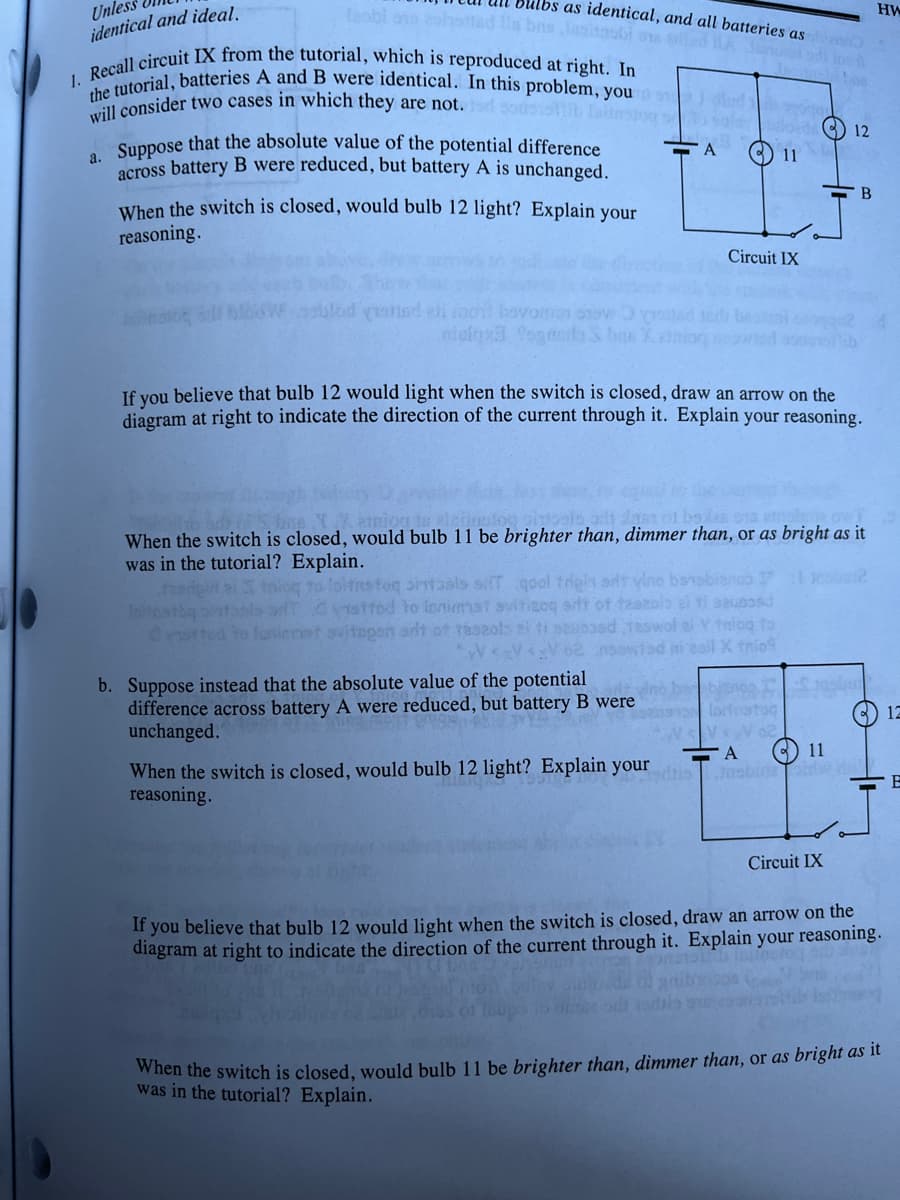1. Recall circuit IX from the tutorial, which is reproduced at right. In the tutorial, batteries A and B were identical. In this problem, you 510 will consider two cases in which they are not. dsusisilb Islinstogo solar a. A (8) 11 across battery B were reduced, but battery A is unchanged. When the switch is closed, would bulb 12 light? Explain your reasoning. Circuit IX lod yashindwi inoil bevoman If you believe that bulb 12 would light when the switch is closed, draw an arrow on the diagram at right to indicate the direction of the current through it. Explain your reasoning. boles When the switch is closed, would bulb 11 be brighter than, dimmer than, or as bright as it was in the tutorial? Explain. to loitusfoq sintasis sT qool trigin at yine benobianco 1:1-2 stfod to lonimmst svititoq art of teazolo ei ti sausosd svitogen art of taszolo zi ti saunosd teswol al V twipo to *N
1. Recall circuit IX from the tutorial, which is reproduced at right. In the tutorial, batteries A and B were identical. In this problem, you 510 will consider two cases in which they are not. dsusisilb Islinstogo solar a. A (8) 11 across battery B were reduced, but battery A is unchanged. When the switch is closed, would bulb 12 light? Explain your reasoning. Circuit IX lod yashindwi inoil bevoman If you believe that bulb 12 would light when the switch is closed, draw an arrow on the diagram at right to indicate the direction of the current through it. Explain your reasoning. boles When the switch is closed, would bulb 11 be brighter than, dimmer than, or as bright as it was in the tutorial? Explain. to loitusfoq sintasis sT qool trigin at yine benobianco 1:1-2 stfod to lonimmst svititoq art of teazolo ei ti sausosd svitogen art of taszolo zi ti saunosd teswol al V twipo to *N
College Physics
11th Edition
ISBN:9781305952300
Author:Raymond A. Serway, Chris Vuille
Publisher:Raymond A. Serway, Chris Vuille
Chapter1: Units, Trigonometry. And Vectors
Section: Chapter Questions
Problem 1CQ: Estimate the order of magnitude of the length, in meters, of each of the following; (a) a mouse, (b)...
Related questions
Question
1a and b please!

Transcribed Image Text:bulbs as identical, and all batteries as
sobi ons zohotted Ils bas lesinabi sad A Joint
HW
Unles
identical and ideal.
1. Recall circuit IX from the tutorial, which is reproduced at right. In
the tutorial, batteries A and B were identical. In this problem, you
will consider two cases in which they are not. odsotsisviib lahtnsions
12
a. Suppose that the absolute value of the potential difference
across battery B were reduced, but battery A is unchanged.
A
11
When the switch is closed, would bulb 12 light? Explain your
reasoning.
Circuit IX
lod yishind all ind
iclaxa fon
If you believe that bulb 12 would light when the switch is closed, draw an arrow on the
diagram at right to indicate the direction of the current through it. Explain your reasoning.
ation to eleito
When the switch is closed, would bulb 11 be brighter than, dimmer than, or as bright as it
was in the tutorial? Explain.
fasripiri
to foitusfoq ortasis sT qool trigin ant yine barobianco Insbul2
Initis
istfod to lonimmst svitigoq srit of tzazolo si ti sausosd
svitogen adt ot taszolo el ti sauoosd teswol el Y twing to
<V <₂V 62 nsowfad ni zail X trio
b. Suppose instead that the absolute value of the potential
difference across battery A were reduced, but battery B were
unchanged.
We vino ba bianca I
stosaloitratoq
VVV 02
A
) 12
11
When the switch is closed, would bulb 12 light? Explain your
reasoning.
B
Circuit IX
If you believe that bulb 12 would light when the switch is closed, draw an arrow on the
diagram at right to indicate the direction of the current through it. Explain your reasoning.
When the switch is closed, would bulb 11 be brighter than, dimmer than, or as bright as it
was in the tutorial? Explain.
B
Expert Solution
This question has been solved!
Explore an expertly crafted, step-by-step solution for a thorough understanding of key concepts.
This is a popular solution!
Trending now
This is a popular solution!
Step by step
Solved in 2 steps with 2 images

Knowledge Booster
Learn more about
Need a deep-dive on the concept behind this application? Look no further. Learn more about this topic, physics and related others by exploring similar questions and additional content below.Recommended textbooks for you

College Physics
Physics
ISBN:
9781305952300
Author:
Raymond A. Serway, Chris Vuille
Publisher:
Cengage Learning

University Physics (14th Edition)
Physics
ISBN:
9780133969290
Author:
Hugh D. Young, Roger A. Freedman
Publisher:
PEARSON

Introduction To Quantum Mechanics
Physics
ISBN:
9781107189638
Author:
Griffiths, David J., Schroeter, Darrell F.
Publisher:
Cambridge University Press

College Physics
Physics
ISBN:
9781305952300
Author:
Raymond A. Serway, Chris Vuille
Publisher:
Cengage Learning

University Physics (14th Edition)
Physics
ISBN:
9780133969290
Author:
Hugh D. Young, Roger A. Freedman
Publisher:
PEARSON

Introduction To Quantum Mechanics
Physics
ISBN:
9781107189638
Author:
Griffiths, David J., Schroeter, Darrell F.
Publisher:
Cambridge University Press

Physics for Scientists and Engineers
Physics
ISBN:
9781337553278
Author:
Raymond A. Serway, John W. Jewett
Publisher:
Cengage Learning

Lecture- Tutorials for Introductory Astronomy
Physics
ISBN:
9780321820464
Author:
Edward E. Prather, Tim P. Slater, Jeff P. Adams, Gina Brissenden
Publisher:
Addison-Wesley

College Physics: A Strategic Approach (4th Editio…
Physics
ISBN:
9780134609034
Author:
Randall D. Knight (Professor Emeritus), Brian Jones, Stuart Field
Publisher:
PEARSON